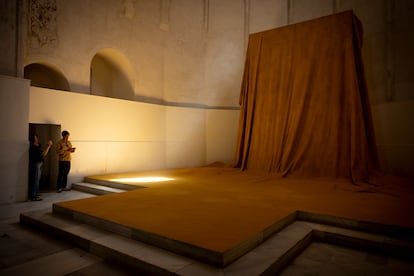Exactly two years after in October 2023 the Andalusian Government unexpectedly appointed curator Jimena Blázquez (Cádiz, 1974) director of the Andalusian Center for Contemporary Art (CAAC), without public competition or prior announcement to the current director at the time, Juan Antonio Álvarez Reyes, who was caught by the news still sitting at his office table, the institution is once again teetering on the dome. Blázquez announced this Wednesday, in an equally surprising manner, his resignation from the position, for which he alleged “personal reasons.”
The entry of Jimena Blázquez as head of the Andalusian museum – one of the most prominent institutions on the national scene in the management, collection and dissemination of contemporary art – was a decision by the previous Minister of Culture and Tourism of the Junta de Andalucía, Arturo Bernal from Malaga, which caused a real commotion in the sector, since it was made as a direct appointment ratified in the Governing Council of the Junta de Andalucía, without public attendance and contravening the recommendations of the Document of Good Practices in Museums and Art Centers in Spain by which these centers have been governed since 2007.
Personalities from the art world, associations and groups then came out in force to support the work carried out by the previous director, Juan Antonio Álvarez Reyes, who had been at the head of the institution since 2010, and caused the resignation en bloc of the CAAC Technical Commission, a consultative body made up until then of such prestigious names as Estrella de Diego, professor at the Complutense University; María Dolores Jiménez Blanco, professor at the same university; Juan Cuenca, artist and architect; Francisco Jarauta, professor at the University of Murcia; and Víctor Pérez Escolano, former director of the Museum of Contemporary Art of Seville and professor of Architecture at the University of Seville, among others.
The protest was not expressly directed at the figure of Blázquez, a doctor in contemporary art, collector, patron, curator and art critic well known in the world of contemporary art throughout the national territory and with a certain international career, but rather at the method chosen for her appointment.
For this reason, the current Minister of Culture and Sports of the Junta de Andalucía, Patricia del Pozo, who had preceded and later replaced Arturo Bernal in office, with visible discrepancies in his management, does not want to repeat mistakes and has announced the call for a public competition to elect the new management of the Center. This selection formula, it was reported in a statement, “will comply with the recommendations of the Document of Good Practices in Museums and Art Centers in Spain.”
Likewise, Del Pozo thanked Jimena Blázquez for “the work carried out during her time at the head of the CAAC, reinforcing her role as a reference within the map of contemporary art in Spain.” “Under his direction, the museum has expanded the institution’s links with the Andalusian context and has gained projection abroad,” he noted.
Blázquez leaves the programming of the Andalusian Center for Contemporary Art (CAAC), in Seville, and the Center for Contemporary Creation of Andalusia (C3A), in Córdoba, closed for the coming years, “guaranteeing institutional continuity” – the Andalusian Government insists to the media -, as well as the expansion of the institution based in the Andalusian capital towards the 15th Century Pavilion of the Exhibition Universal of 1992 (annex to the Cartuja monastery), whose opening is scheduled for 2026.
The direction of the CAAC is one of the most attractive positions within the national contemporary art sector, since the Andalusian museum – an autonomous body inserted within the organizational chart of the Ministry of Culture of the Government of Andalusia – assumes the management of the collections of the former Monumental Complex of the Cartuja and the Museum of Contemporary Art of Seville, and competes on equal terms with other national institutions of its kind, such as the Valencian Institute of Modern Art (IVAM), the MUSAC in León or the Patio Herreriano Museum in Valladolid.

